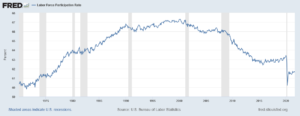October 09, 2021
Some folks recognize various bird cries, others can identify the howling of a wolf, but any good economist can quickly recognize the “it’s hard to get good help” cry of the privileged. The Washington Post gave columnist Gary Abernathy the opportunity to make his cry at length today.
Abernathy is upset that we took steps to prevent people from getting sick and dying from the pandemic, but what he’s really upset about now is that many people no longer feel that they have to take any job that an employer is offering. The problem is that we gave them too much money, so workers are no longer desperate.
“One of the biggest incentives to work is earning enough to pay for the necessities of life and possibly something more, with the understanding that not everyone will have everything in equal measure. When the fruits of that labor are provided from the public trough in amounts far exceeding a basic social safety net, it’s only natural that fewer people will be motivated to work. Even with higher wages, it’s more difficult than ever to recruit people for unglamorous service-industry jobs.”
The little factoid that is the highlight of Abernathy’s argument is in a quote he takes from NBC:
“The last time labor force participation was this low was more than 40 years ago, in January 1977.”
That is supposed to sound very scary, but it is actually not the least bit scary to anyone who is all familiar with labor market data. Here’s a picture of labor force participation rates over the last half century.

As can be seen, the labor force participation rate (LFPR) rose sharply through the 1970s and 1980s. This was the story of women entering the paid labor force. The rate then stagnated in the 1990s, as the rise in women’s LFPR slowed, and prime-age men (ages 25 to 54) dropped out, as did teens. The LFPR has been on a downward trend for the last two decades, primarily because the population is aging, and people in their 70s, 80s and 90s mostly don’t work.
Given this history, the statement that the LFPR is the lowest since 1977 is not telling us much. In September of 2015 it was at the lowest level since October of 1977, so what?
Okay, so maybe no one takes Abernathy and his nonsense seriously, but the question is why does the Washington Post print it? I’m fine with diverse opinions, but the Post can demand that its opinion writers not play such obviously misleading games.
There is also the question of why do we have to hear so much from people complaining that working people and the poor are getting too much money. We literally never hear from anyone who complains that we give too much to billionaires by giving them government-granted patent and copyright monopolies. While the Washington Post is happy to give people a forum to complain that $300 weekly unemployment insurance supplements are too generous, it will not allow the billions handed to drug companies and other beneficiaries of these monopolies to be questioned on its pages.
Abernathy’s story is ridiculous, but it’s the Post’s fault that he has a big megaphone.







Comments